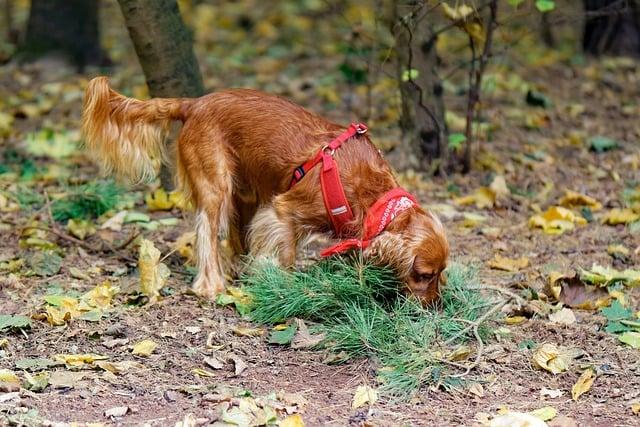Imagine a loyal dog named Max, who eagerly awaits his owner’s return each day. One evening, his owner forgets to feed him, and as the hours turn into days, Max’s energy wanes. Dogs can survive without food for about 3 to 5 days, but this varies based on their health and hydration. Prolonged fasting can lead to serious health issues. As responsible pet owners, we must prioritize their well-being. Let’s ensure our furry friends never face hunger, for their love and loyalty deserve our utmost care.
Contents
- Understanding the Nutritional Needs of Dogs for Optimal Health
- Recognizing the Signs of Hunger and Starvation in Dogs
- Exploring the Risks of Prolonged Food Deprivation in Canines
- Implementing Safe Feeding Practices to Ensure Your Dogs Well-Being
- Q&A
Understanding the Nutritional Needs of Dogs for Optimal Health
When considering how long a dog can survive without food, it’s essential to recognize that nutritional needs vary significantly based on factors such as age, breed, size, and overall health. While dogs can endure short periods without food, this does not mean it is safe or healthy for them. In fact, a lack of proper nutrition can lead to serious health issues, including muscle loss, weakened immune function, and organ failure.
Typically, a healthy dog can go without food for about 3 to 5 days, but this timeframe can differ. Puppies, senior dogs, and those with pre-existing health conditions may not withstand fasting as well as their healthier counterparts. During this time, hydration becomes crucial; dogs can only survive a few days without water, making it imperative to ensure they have access to fresh water at all times.
Understanding the signs of hunger and malnutrition is vital for dog owners. Some common indicators that your dog may be struggling include:
- Weight loss – Noticeable changes in body condition.
- Lethargy – Reduced energy levels and playfulness.
- Behavior changes – Increased irritability or anxiety.
- Digestive issues – Vomiting or diarrhea.
To promote optimal health, it is crucial to provide a balanced diet tailored to your dog’s specific needs. This includes high-quality proteins, healthy fats, carbohydrates, vitamins, and minerals. Regular veterinary check-ups can help ensure that your dog is receiving the right nutrition and can help identify any potential health issues before they become serious. Remember, a well-nourished dog is not only happier but also more resilient to the challenges of life.
Recognizing the Signs of Hunger and Starvation in Dogs
Understanding the signs of hunger and starvation in dogs is crucial for any pet owner. Dogs may exhibit various behaviors when they are hungry or malnourished. **Common signs include**:
- Increased vocalization, such as whining or barking.
- Begging for food or scavenging around the house.
- Changes in behavior, such as lethargy or irritability.
- Weight loss or a noticeable decrease in body condition.
As a responsible pet owner, it’s essential to monitor your dog’s eating habits closely. If your dog suddenly refuses to eat or shows a lack of interest in food, it may indicate a more serious issue. **Look for these additional signs**:
- Changes in stool consistency, which may become loose or infrequent.
- Excessive drooling or licking of lips, which can signal nausea.
- Visible ribs or spine, indicating significant weight loss.
- Behavioral changes, such as hiding or seeking isolation.
Starvation can lead to severe health complications, including organ failure and weakened immune response. It’s vital to recognize that prolonged periods without food can have devastating effects on your dog’s overall health. **If you notice any of the following symptoms**, it’s imperative to seek veterinary assistance immediately:
- Severe lethargy or weakness.
- Persistent vomiting or diarrhea.
- Seizures or disorientation.
- Unusual aggression or fearfulness.
Being proactive about your dog’s nutrition can prevent these alarming signs from developing. Regular feeding schedules and monitoring your dog’s weight can help ensure they receive the necessary nutrients. **If you suspect your dog is experiencing hunger or starvation**, consult with a veterinarian to determine the best course of action and to address any underlying health issues.
Exploring the Risks of Prolonged Food Deprivation in Canines
Prolonged food deprivation in canines can lead to serious health complications that pet owners must be aware of. When a dog goes without food for an extended period, the body begins to utilize its fat reserves for energy. While this may seem like a natural survival mechanism, it can quickly spiral into a dangerous situation. The breakdown of fat leads to the release of toxins into the bloodstream, which can overwhelm the liver and result in severe organ damage.
Additionally, the lack of essential nutrients can cause a range of physiological issues. Dogs deprived of food may experience:
- Muscle wasting: The body starts to break down muscle tissue for energy, leading to weakness and lethargy.
- Weakened immune system: A lack of proper nutrition compromises the immune response, making dogs more susceptible to infections.
- Gastrointestinal problems: Prolonged fasting can disrupt the digestive system, leading to issues such as vomiting or diarrhea when food is reintroduced.
Moreover, the psychological effects of food deprivation should not be underestimated. Dogs are social animals that thrive on routine and stability. When they are deprived of food, they may exhibit signs of anxiety or stress, which can manifest in destructive behaviors or changes in temperament. This emotional toll can create a ripple effect, impacting the bond between the dog and its owner.
It is crucial for pet owners to recognize the signs of food deprivation and act swiftly. If a dog has not eaten for more than 24 hours, it is advisable to consult a veterinarian. Early intervention can prevent the onset of serious health issues and ensure that your furry companion remains happy and healthy. Remember, a well-fed dog is not just a happy dog; it is also a dog that can thrive both physically and emotionally.
Implementing Safe Feeding Practices to Ensure Your Dogs Well-Being
When it comes to your dog’s health, implementing safe feeding practices is crucial. Dogs, like humans, require a balanced diet to thrive, and ensuring they receive the right nutrients is essential for their overall well-being. Feeding your dog the appropriate amount of food at regular intervals helps maintain their energy levels and supports their immune system. Remember, a well-fed dog is a happy dog, and a happy dog is less likely to develop behavioral issues related to hunger or anxiety.
Understanding your dog’s specific dietary needs is vital. Factors such as age, breed, size, and activity level all play a significant role in determining how much and how often you should feed your furry friend. For instance, puppies require more frequent meals to support their rapid growth, while older dogs may benefit from smaller, more digestible portions. Consulting with your veterinarian can provide tailored advice, ensuring your dog receives the right balance of proteins, fats, and carbohydrates.
In addition to portion control, the quality of the food you provide is equally important. Opt for high-quality dog food that lists real meat as the first ingredient and avoids fillers and artificial additives. This not only enhances your dog’s health but also contributes to a shiny coat and healthy skin. Regularly check the expiration dates on food packages and store them in a cool, dry place to prevent spoilage. Remember, feeding your dog fresh, nutritious food is a fundamental aspect of their care.
Lastly, establishing a consistent feeding schedule can help regulate your dog’s digestion and prevent overeating. Dogs thrive on routine, and knowing when to expect their meals can reduce anxiety and promote a sense of security. Consider using feeding puzzles or slow feeders to make mealtime more engaging and to prevent rapid eating, which can lead to digestive issues. By prioritizing safe feeding practices, you are not only enhancing your dog’s quality of life but also fostering a deeper bond built on trust and care.
Q&A
-
How many days can a dog survive without food?
Generally, a dog can survive without food for about 3 to 5 days, depending on various factors such as age, health, and hydration. However, this is not a safe or healthy situation for your pet.
-
What happens to a dog’s body when it goes without food?
When a dog goes without food, its body begins to use stored energy reserves. Initially, it will use glycogen from the liver, followed by fat and muscle. Prolonged fasting can lead to serious health issues, including organ failure.
-
Can a dog go without food if it is drinking water?
While hydration is crucial, water alone cannot sustain a dog for an extended period. Nutritional needs must be met to maintain energy levels and overall health. A lack of food can lead to malnutrition, even if water is available.
-
What should I do if my dog refuses to eat?
If your dog refuses to eat for more than 24 hours, it’s essential to consult a veterinarian. Loss of appetite can be a sign of underlying health issues that require immediate attention.
while dogs can survive several days without food, it’s crucial to prioritize their health and well-being. Always consult a veterinarian if your pet refuses to eat. Remember, a well-fed dog is a happy dog!

大家好,我是彼得潘,專業的手法身體治療師。我喜歡探索和研究各種主題,並透過與人工智慧的合作分享專業、實用、有趣的文章。我們定期進行人工審核,以確保內容的準確性。如果您發現文章中有任何不準確的地方,請隨時與我們聯繫,我們會及時糾正。您可以透過 [email protected] 與我們聯繫。



